› Forums › Variable Stars › Wolf Rayets and Symbiotics spectra – a busy night!
- This topic has 15 replies, 3 voices, and was last updated 10 years, 3 months ago by
 john simpson.
john simpson.
-
AuthorPosts
-
14 September 2015 at 12:01 am #573472
 Steve CuthbertParticipant
Steve CuthbertParticipantHi guys
Hugely enjoyable night tonight (12/09/15) with everything working like it should (really liking Windows 10 now!) first clear night since god knows when and concentrated around Pegasus and Cygnus .
Chi Cyg
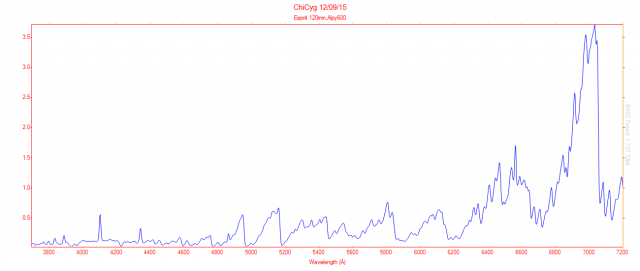
and a comparison with my last Chi Cyg spectrum
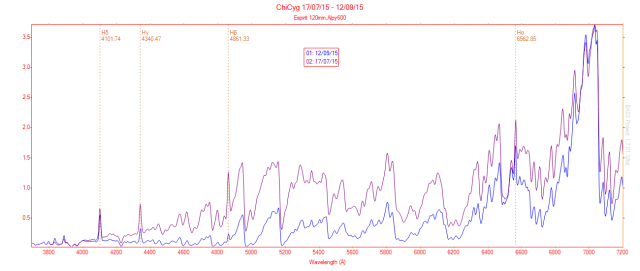
AG Peg very crisp emission lines
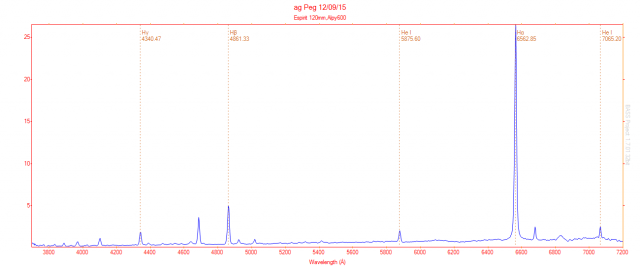
a few Wolf Rayets in Cygnus V0444,V1687 and WR136
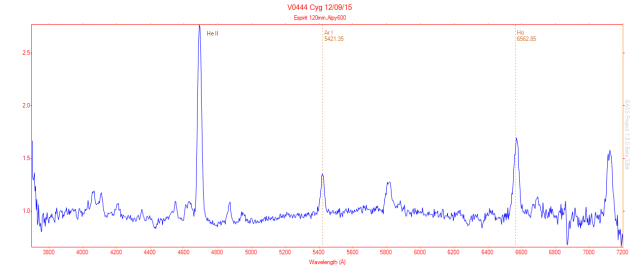
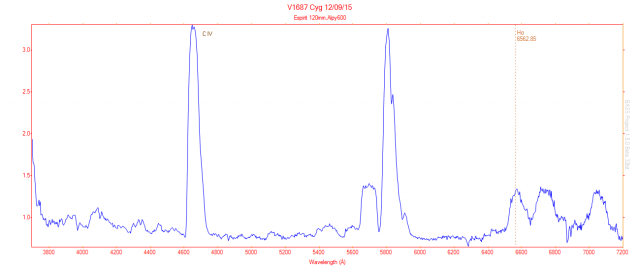
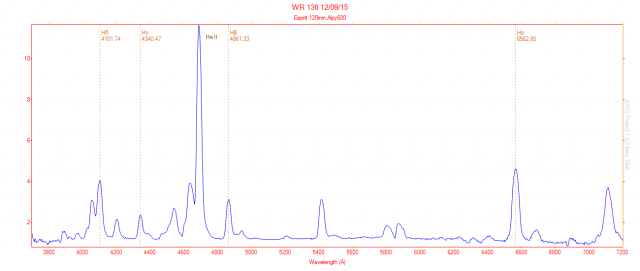
and finally one of my favourites P Cyg
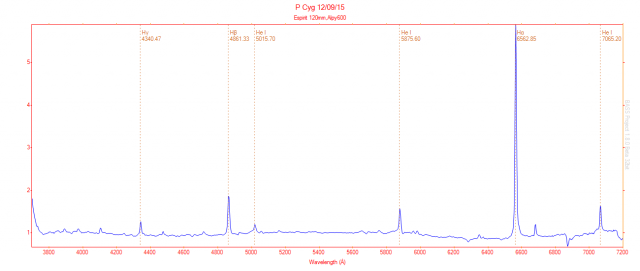
cheers
Steve
15 September 2015 at 9:30 pm #577037 Andy WilsonKeymaster
Andy WilsonKeymasterThose a great spectra Steve. That really was a busy night for you with lots of different stars. The biggest obvious change I can see in chi Cyg is the H-Beta line has dropped in strength.
They look as though they might have instrument and atmospheric correction? Is that right?
Cheers,
Andy
16 September 2015 at 11:22 am #577041 Steve CuthbertParticipant
Steve CuthbertParticipantHi Andy
Yes corrected using alpha Peg although maybe not the best candidate as its a B9III type!
Steve
16 September 2015 at 8:30 pm #577042 Andy WilsonKeymaster
Andy WilsonKeymasterHi Steve,
Great, the continuum did look as though it had been corrected. As I understand it to get best quality results using a reference star at similar altitude to the target is the important thing, within reason. I think I’m getting better at these corrections, but I still need more practice. I have been experimenting by taking spectra of 2 standard stars and comparing the correction curves.
Really nice results you got that night. It is fantastic when everything comes together.
Cheers,
Andy
16 September 2015 at 10:51 pm #577044 Steve CuthbertParticipant
Steve CuthbertParticipantHi Andy
Yes I agree about the refererence star at same altitude although I can`t always find one ;-).
Have you tried the reference star spreadsheet for spectro mentioned on the spectro-aras forum here
http://www.astronomie-amateur.fr/Documents%20Spectro/ReferenceStarFinder.xlsm
I`m using Open Office and couldn`t quite get it to work properly but I`ll stick with it!.
Hopefully stuff like this will be covered at Sidmouth, you got your presentation finished ok?
cheers
Steve
17 September 2015 at 7:19 pm #577046 Andy WilsonKeymaster
Andy WilsonKeymasterHi Steve,
Yes, I’ve seen that spreadsheet, though I’ve also been using one titled “MILES_SEARCH_V1_excel2010_64bit.xlsm”. This was created by Paolo Berardi and Marco Leonardi and can be accessed from the following ARAS thread.
http://www.spectro-aras.com/forum/viewtopic.php?f=8&t=941
It may well has the same issues for you being designed for Excel, but you never know.
Yes, finding good reference stars can be rather tricky. I’ve certainly not got things working perfectly yet myself but I’m gaining experience and improving all the time.
I’ve got my presentation finished in draft. Just deciding what to keep and what to throw out.
Cheers,
Andy
17 September 2015 at 8:50 pm #577047 Steve CuthbertParticipant
Steve CuthbertParticipantThanks for that link Andy, that spreadsheet looks easier to use and seems to contain more info, I`ll try that later!.
Steve
19 September 2015 at 10:27 pm #577050 Steve CuthbertParticipant
Steve CuthbertParticipantHi again Andy
That spreadsheet looks very good. Not sussed out how to use it yet though??
cheers
Steve
20 September 2015 at 11:13 am #577052 Andy WilsonKeymaster
Andy WilsonKeymasterHi Steve,
I’ll have my laptop at Sidmouth, so we can always look at it there. I’m staying in the area on both Friday and Saturday nights.
Cheers,
Andy
20 September 2015 at 7:14 pm #577053 Steve CuthbertParticipant
Steve CuthbertParticipantExcellent look forward to that Andy.
cheers
Steve
21 September 2015 at 4:30 pm #577057 john simpsonParticipant
john simpsonParticipantHi Steve, Andy,
Thought I’d add one more to your impressive collection – as well as AG Pegasi & Chi Cygni I chose to follow CH Cygni. Even at low resolution CH Cygni is a real gem for a beginner to follow and try to understand – changes in the spectrum abound – this plot shows changes to H and He lines in just a month [He disappear!]. I used iota CYG as reference. Wondered if you could give some tips on how to normalise in situations like this when continuum so broken up?
Cheers
john s
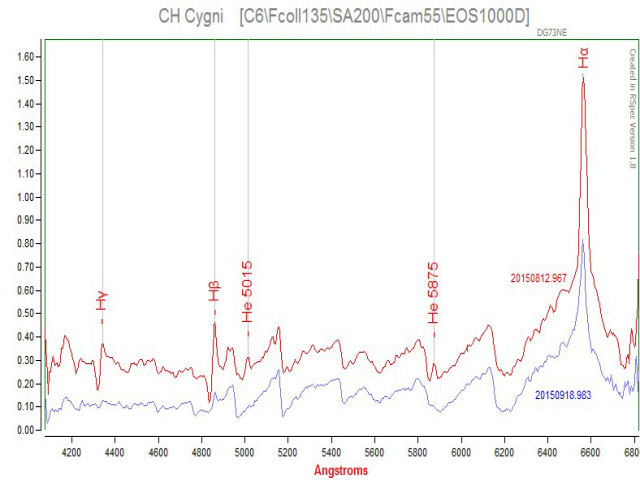 21 September 2015 at 6:48 pm #577058
21 September 2015 at 6:48 pm #577058 Andy WilsonKeymaster
Andy WilsonKeymasterHi John,
Those are some very interesting changes that you have picked up in the spectrum of CH Cygni. If you are correcting the spectrum for instrumental and atmospheric response then there is no need to normalise it. In fact those corrections are better than normalising the spectrum. The bumpy spectrum is that of the red giant in the system. Rather than a smooth continuum it has absorption bands, almost certainly due to titanium oxide in the star’s atmosphere.
For comparison here is a spectrum I took on 6th August.
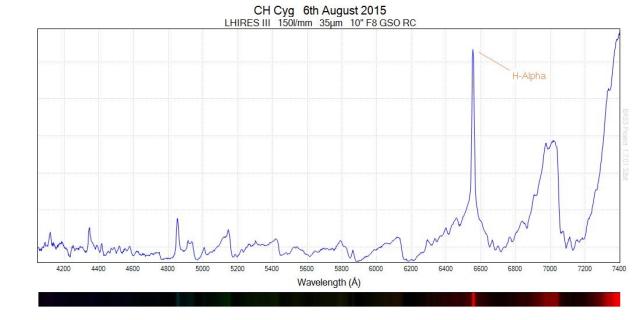
Best wishes,
Andy
21 September 2015 at 7:35 pm #577059 Steve CuthbertParticipant
Steve CuthbertParticipantHi guys
Excellent well calibrated spectrum John, you can easily see the difference in Helium emission between the 2 dates.
I must checkout CH Cyg next time 😉
Steve
21 September 2015 at 8:19 pm #577060 Andy WilsonKeymaster
Andy WilsonKeymasterHi John and Steve,
Do I have your permission to post some of your spectra to the VSS Facebook page? John I think your above spectrum of CH Cyg would make a very interesting post. Steve, I was thinking of posting one of you Chi Cyg spectra, if that is OK?
Thanks,
Andy
21 September 2015 at 9:03 pm #577061 Steve CuthbertParticipant
Steve CuthbertParticipantNo probs at all Andy!
Steve
21 September 2015 at 9:21 pm #577062 john simpsonParticipant
john simpsonParticipantHi Andy,
Yes – happy for you to use whatever you want. My reason for earlier question about normalisation of spectra was that I took sets of images in between the dates given in the figure. Haven’t processed all of them yet, but had it in mind to see if I could put some numbers to any changes by measuring equivalent widths if possible [Richard Walker document explains how to do this and Rspec has facility to do the measurements – not sure how accurate though – would be first try out of it].
Cheers
john s
-
AuthorPosts
- You must be logged in to reply to this topic.
